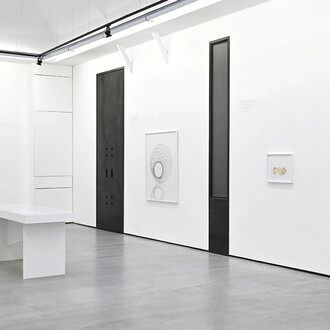When I started making pottery again in 2004 after a long hiatus, my desire was to get to the very core of the ceramic process and the history of pottery. Glazes that melt, fuse, bubble, crawl, and drip in the heat of the kiln covering minimal pottery forms that defy gravity, with the result being a narration of that process frozen in time.
To me, the one essential ingredient of all good art - whether it is visual art, music, literature, theater, dance, or film – is that it has tension. Without tension, it isn’t art. Jazz has tension; elevator music does not. My work is the study the tension between what might be considered ugly or abject, and what might be considered beautiful. And, to be critical of my own work, as hard as I try to find the point right in the middle, it usually ends up more toward the latter.
I’ve been asked why I make forms that are so simple and modernist. I’ve studied ceramics for so long that the forms are a distillation of all the historic pottery that has spoken to me, without being specific to any. Because I want to create tension between the forms and the surface, either the form or the surface has to be simple, and (hint) it’s not the glazes. I hang complex, sometimes even ugly glazes on forms that I hope have a kind of simple elegance.
I’d go crazy if I had to use paint to achieve the look I want for my work. Like so many potters of the past, the kiln is my partner. Painters sometimes go crazy when they use fired ceramic glazes, because glazes are so unpredictable and because before firing they all look like different shades of dull grey and brown. To use glazes well, one must see them in the mind’s eye before firing.
It’s often said that ceramics is a very technical art form. And it is. The problem with that is that that if you get lost in the technical, it’s hard to find your way to the art. But if you avoid the technical, you won’t be able to realize your vision.
With the glazes and firings, I create a situation where there is only partial predictability of what will happen during the firing, but it is by no means random. If I used a glaze that was utterly predictable, I would switch to one that is not. The glazes I use are my own invention and are the result of hundreds, if not thousands, of tests. But really the way I approach glaze formulation, I’m more of a cook than a chemist, adding a pinch of this or a pinch to find the desired result.
Most of the recent pieces allude to landscape, intentionally so. After all, I grew up in Arizona, which is a land of vast desert landscapes, but it is also rich in intimate pictorial spaces found in small rocks and stones. Some of the pieces have an obvious horizon line, giving them a distant landscape, while others depict an intimate landscape through which we travel – whether literally or in our minds - without a specific reference.
In the end, what I make is pottery just pottery. I’m not interested in calling it ceramic art or sculptural ceramics. It’s pottery, plain and simple, because that is the language that it speaks and the history from which it comes, and to whom it speaks. If my work is successful, I like to think that it is kind of conversation with potters that came before me, and the ones who will come after.
















